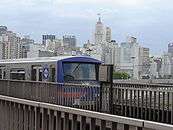Line 3 (São Paulo Metro)
| São Paulo Metro Line 3 (Red) | ||||||||||||||||||||||||||||||||||||||||||||||||||||||||||||||||||||||||||||||||||||||||||||||||||||||||||||||||||||||||||||||||||||||||||||||||||||||||||||||||||||||||||||||||||||||
|---|---|---|---|---|---|---|---|---|---|---|---|---|---|---|---|---|---|---|---|---|---|---|---|---|---|---|---|---|---|---|---|---|---|---|---|---|---|---|---|---|---|---|---|---|---|---|---|---|---|---|---|---|---|---|---|---|---|---|---|---|---|---|---|---|---|---|---|---|---|---|---|---|---|---|---|---|---|---|---|---|---|---|---|---|---|---|---|---|---|---|---|---|---|---|---|---|---|---|---|---|---|---|---|---|---|---|---|---|---|---|---|---|---|---|---|---|---|---|---|---|---|---|---|---|---|---|---|---|---|---|---|---|---|---|---|---|---|---|---|---|---|---|---|---|---|---|---|---|---|---|---|---|---|---|---|---|---|---|---|---|---|---|---|---|---|---|---|---|---|---|---|---|---|---|---|---|---|---|---|---|---|---|
|
| ||||||||||||||||||||||||||||||||||||||||||||||||||||||||||||||||||||||||||||||||||||||||||||||||||||||||||||||||||||||||||||||||||||||||||||||||||||||||||||||||||||||||||||||||||||||
| Overview | ||||||||||||||||||||||||||||||||||||||||||||||||||||||||||||||||||||||||||||||||||||||||||||||||||||||||||||||||||||||||||||||||||||||||||||||||||||||||||||||||||||||||||||||||||||||
| Type | Rapid transit | |||||||||||||||||||||||||||||||||||||||||||||||||||||||||||||||||||||||||||||||||||||||||||||||||||||||||||||||||||||||||||||||||||||||||||||||||||||||||||||||||||||||||||||||||||||
| System | São Paulo Metro | |||||||||||||||||||||||||||||||||||||||||||||||||||||||||||||||||||||||||||||||||||||||||||||||||||||||||||||||||||||||||||||||||||||||||||||||||||||||||||||||||||||||||||||||||||||
| Status | Operational | |||||||||||||||||||||||||||||||||||||||||||||||||||||||||||||||||||||||||||||||||||||||||||||||||||||||||||||||||||||||||||||||||||||||||||||||||||||||||||||||||||||||||||||||||||||
| Locale | São Paulo, Brazil | |||||||||||||||||||||||||||||||||||||||||||||||||||||||||||||||||||||||||||||||||||||||||||||||||||||||||||||||||||||||||||||||||||||||||||||||||||||||||||||||||||||||||||||||||||||
| Termini |
Palmeiras-Barra Funda Corinthians-Itaquera | |||||||||||||||||||||||||||||||||||||||||||||||||||||||||||||||||||||||||||||||||||||||||||||||||||||||||||||||||||||||||||||||||||||||||||||||||||||||||||||||||||||||||||||||||||||
| Stations | 18 | |||||||||||||||||||||||||||||||||||||||||||||||||||||||||||||||||||||||||||||||||||||||||||||||||||||||||||||||||||||||||||||||||||||||||||||||||||||||||||||||||||||||||||||||||||||
| Operation | ||||||||||||||||||||||||||||||||||||||||||||||||||||||||||||||||||||||||||||||||||||||||||||||||||||||||||||||||||||||||||||||||||||||||||||||||||||||||||||||||||||||||||||||||||||||
| Opened | March 10, 1979 | |||||||||||||||||||||||||||||||||||||||||||||||||||||||||||||||||||||||||||||||||||||||||||||||||||||||||||||||||||||||||||||||||||||||||||||||||||||||||||||||||||||||||||||||||||||
| Operator(s) | Companhia do Metropolitano de São Paulo | |||||||||||||||||||||||||||||||||||||||||||||||||||||||||||||||||||||||||||||||||||||||||||||||||||||||||||||||||||||||||||||||||||||||||||||||||||||||||||||||||||||||||||||||||||||
| Technical | ||||||||||||||||||||||||||||||||||||||||||||||||||||||||||||||||||||||||||||||||||||||||||||||||||||||||||||||||||||||||||||||||||||||||||||||||||||||||||||||||||||||||||||||||||||||
| Line length | 22 kilometres (14 mi) | |||||||||||||||||||||||||||||||||||||||||||||||||||||||||||||||||||||||||||||||||||||||||||||||||||||||||||||||||||||||||||||||||||||||||||||||||||||||||||||||||||||||||||||||||||||
| Track gauge | 1,600 mm (5 ft 3 in) 750 V DC third rail | |||||||||||||||||||||||||||||||||||||||||||||||||||||||||||||||||||||||||||||||||||||||||||||||||||||||||||||||||||||||||||||||||||||||||||||||||||||||||||||||||||||||||||||||||||||
| ||||||||||||||||||||||||||||||||||||||||||||||||||||||||||||||||||||||||||||||||||||||||||||||||||||||||||||||||||||||||||||||||||||||||||||||||||||||||||||||||||||||||||||||||||||||
Line 3 (Red) of the São Paulo Metro covers the stretch of the metro network between Palmeiras-Barra Funda and Corinthians-Itaquera. It was formerly called the East-West Line. Line 3 is the busiest in the system.[1]
History
This line, initially called the East-West line, was only planned to be 7 kilometres (4.3 mi) long, connecting the Casa Verde and Vila Maria districts of São Paulo, passing through the center of Barra Funda, Sé, and Tatuapé, and be completely underground. But after a lengthy debate, it was decided that it would be constructed on the surface, taking advantage of the old Rede Ferroviária Federal train bed and sharing 23 kilometres (14 mi) of its lines—a move that prevented many expropriations.[2]

Construction began in 1972. With this design change, the East-West line would then be more than 30 kilometres (19 mi) long between Praça da Sé and Guaianases, parallel to the railroad tracks. The stretch between Guaianases and Calmon Viana, in Poá was planned to be built in a second phase, making full use the rail bed. The strength of this design change would be a cost equivalent to one third of the original budget. Because of international trends that dictate that the rail for metro systems used for urban transport be made exclusive to the metro, the design was changed again.[3]

It was up to the Rede Ferroviária Federal (predecessor of CPTM) to modernize this passage. For this reason, the line opened already overloaded. Once this impasse was resolved, construction began on the western section. On March 10, 1979 the first stretch, between Sé and Brás stations was opened. In the west, the line ended in Barra Funda. The current configuration is the same since 1988. The current record demand was made on November 7, 2008, with the transport of 1,468,935 people. On May 2–3, 2009 the stretch between Anhangabaú and Santa Cecília stations was closed to allow for the use of a tunnel boring machine being used for the extension project of Line 4 (Yellow). In 2010 work began on the installation of glass doors on the Line 3 platforms, starting with the Vila Matilde, Carrão and Penha stations.[1]
Expansion
An expansion is planned from Palmeiras-Barra Funda to Pio XI. Another extension is planned from Corinthians-Itaquera to Jacu Pêssego.
Stations
References
- 1 2 Daniel Gonzales. "Portas de plataforma serão instaladas em mais 7 estações do Metrô neste ano" (in Portuguese). Estadão.com.br. Retrieved 2010-05-27.
- ↑ "A linha vai correr pelos leitos da Central", Jornal da Tarde, 8/16/1973, pg. 16
- ↑ "Metrô | Companhia do Metropolitano de São Paulo". Metro.sp.gov.br. Retrieved 2014-02-02.
